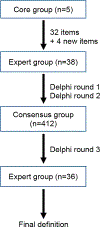Redefining Palliative Care-A New Consensus-Based Definition
- PMID: 32387576
- PMCID: PMC8096724
- DOI: 10.1016/j.jpainsymman.2020.04.027
Redefining Palliative Care-A New Consensus-Based Definition
Abstract
Context: The International Association for Hospice and Palliative Care developed a consensus-based definition of palliative care (PC) that focuses on the relief of serious health-related suffering, a concept put forward by the Lancet Commission Global Access to Palliative Care and Pain Relief.
Objective: The main objective of this article is to present the research behind the new definition.
Methods: The three-phased consensus process involved health care workers from countries in all income levels. In Phase 1, 38 PC experts evaluated the components of the World Health Organization definition and suggested new/revised ones. In Phase 2, 412 International Association for Hospice and Palliative Care members in 88 countries expressed their level of agreement with the suggested components. In Phase 3, using results from Phase 2, the expert panel developed the definition.
Results: The consensus-based definition is as follows: Palliative care is the active holistic care of individuals across all ages with serious health-related suffering due to severe illness and especially of those near the end of life. It aims to improve the quality of life of patients, their families and their caregivers. The definition includes a number of bullet points with additional details as well as recommendations for governments to reduce barriers to PC.
Conclusion: Participants had significantly different perceptions and interpretations of PC. The greatest challenge faced by the core group was trying to find a middle ground between those who think that PC is the relief of all suffering and those who believe that PC describes the care of those with a very limited remaining life span.
Keywords: Definition of palliative care; Delphi method; consensus; low or middle income countries; quality of life; relief of suffering.
Copyright © 2020 The Authors. Published by Elsevier Inc. All rights reserved.
Figures
References
-
- World Health Organization, United Nations Children’s Fund. Declaration of Astana. 2018. Available from https://www.who.int/docs/default-source/primary-health/declaration/gcphc.... Accessed April 24, 2019.
-
- World Health Organization. Health in 2015: from MDGs, millennium development goals to SDGs, sustainable development goals. 2015. Available from https://www.who.int/gho/publications/mdgs-sdgs/en/. Accessed April 24, 2019.
-
- Worldwide Palliative Care Alliance. Global Atlas of Palliative Care at the end of life. 2014. Available from http://www.who.int/nmh/Global_Atlas_of_Palliative_Care.pdf. Accessed March 16, 2015.
-
- Knaul FM, Farmer PE, Krakauer EL, et al. Alleviating the access abyss in palliative care and pain relief—an imperative of universal health coverage: the Lancet Commission report. Lancet 2018;391:1391–1454. - PubMed
-
- Gomez-Batiste X, Connor S. Building integrated palliative care programs and services. Barcelona: Liberdúplex, 2017.
MeSH terms
Grants and funding
LinkOut - more resources
Full Text Sources
Medical



